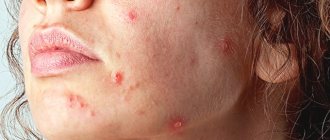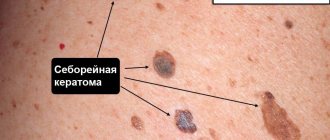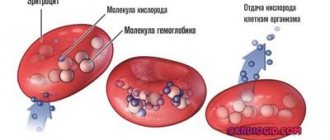REMOVAL OF NEW PLANTS
LASER KERATOMA REMOVAL
Duration of the procedure:
5-30 min.
Number of procedures:
1
Price:
from 200 rub. (depending on the category of complexity of the tumor + anesthesia)
Recovery period: 7-14 days
Equipment: CO2 laser
The number of people experiencing keratoma has increased significantly. Until now, it was generally accepted that this phenomenon is more typical for representatives of older generations who have crossed the 40-year mark. Due to age-related changes, various types of spots appear on their skin.
Today, doctors have come to a disappointing conclusion: keratoma is increasingly developing in young men and women, and moreover, in teenagers. The main cause of this problem is seen in excessive ultraviolet radiation.
Causes of skin keratinization
This disease is not congenital and occurs today in young people, starting from 30-35 years old. Single or multiple keratomas most often appear on the skin after 40-50 years. The main reasons for their formation are:
- age-related disruption of the mechanism of cell division and skin pigment production;
- abuse of sunbathing;
- malfunctions of the immune system;
- hormonal disorders associated with menopause;
- endocrine pathologies
- hereditary predisposition.
Prices for keratoma removal in Moscow are quite affordable, so if you notice such a tumor, sign up for a consultation with a specialist at the Podology Clinic. A surgeon or dermatologist will diagnose and remove the formation.
Possible complications and consequences of laser intervention
Laser surgery of neoplasms can leave scars - small and unnoticeable, or larger ones if the keratoma was initially large. In addition, patients note the appearance of numbness in the tissue at the site where the tumor was removed.
Such manifestations are natural consequences of the procedure.
It is necessary to pay attention to some dangerous symptoms of poorly carried out destruction of the tumor, for example, the appearance of redness around the crust formed after removal, severe itching or rash at the site of the keratoma.
If the crust has fallen off on its own, and underneath it an ulcer in the form of a red spot with an uneven surface is found that has not healed for a long time, you need to visit a dermatologist as soon as possible.
In addition, allergic reactions or dermatitis may develop around the procedure site due to constant wearing of a bandage, as well as the use of various ointments on the skin. At the first manifestations of dermatitis or allergic rashes, you must stop treating the area with any medications and also consult a dermatologist.
Types of keratomas
The described pathology can have several forms. The most common of them:
- Senile (senile). A common type of this skin disease. Such formations look like dark spots that appear mainly on open areas of the skin.
- Solar (solar). When removing a keratoma on the face, the doctor most often deals with this particular form. Such formations are nodules of various sizes and shades - from flesh-colored to red and gray-black.
- Seborrheic. The spots are yellow-brown in color, grow slowly, and are often covered with multi-layered crusts. Locations: head, chest, back, shoulders.
Wound surface care techniques
After laser destruction of the keratoma, a characteristic dark brown crust forms in its place. It covers the surface of the wound, and underneath it the tissue healing process is actively occurring. It is strictly forbidden to rip off or comb the scab, as this opens the door for pathogenic microorganisms to enter the wound until the need for it disappears - then it disappears on its own. For the first two days, it is not recommended to wet the wound site.
Postoperative care includes the following rules: once or twice a day, the procedure site must be washed with water and baby soap, after which it is necessary to treat the surface with antiseptic drugs and healing ointments. Next, a sterile gauze bandage is applied to the wound. If possible, it is better not to use an adhesive plaster, as it restricts air flow into the wound, thereby slowing down its healing.
Complete skin restoration occurs after 4-6 weeks. During this entire time, it is prohibited to visit the bathhouse, sauna, or swim in pools or open reservoirs. Exposure to ultraviolet rays is also undesirable, and not only during postoperative recovery, but also in the next 6-8 months, in order to avoid recurrence of keratoma, so it is better to forget about beaches and solariums for a while, and go outside in clothes or a hat that covers the affected area and treat it with sunscreen with a high UV filter.
Basic methods for removing keratomas
For radical treatment of this disease, physical and surgical methods of removing keratomas are more often used. Their essence lies in the complete destruction of the formation or its removal from the surface of the skin. Using traditional methods or entrusting the excision of keratoma to someone other than a doctor is very dangerous. The consequences of this can be the most serious - from tissue infection to tumor degeneration.
Basic surgical methods for removing keratomas:
- Laser. A quick and painless way. The formation is evaporated by a laser beam.
- Radio wave destruction (“Surgitron”). Removal of keratoma using radio waves is most often used to remove formations on the face and body.
- Electrocoagulation. Thermal treatment of nodules and spots using high-frequency current.
- Surgical excision. The formation is removed with a scalpel, under local anesthesia, followed by suturing.
The choice of method for removing papillomas - skin keratomas, both single and multiple, depends on their size, type, shape and some other factors. Relative contraindications to such operations may include pregnancy, lactation, infectious diseases, and diabetes. Your doctor will tell you about the possibility of treatment in these cases.
What is the essence of the laser method for treating skin diseases?
The appearance of the laser as a physical phenomenon became possible after Albert Einstein developed the theory of interaction between matter and radiation at the beginning of the 20th century. It traced ideas for the possible creation of quantum radiation amplifiers and generators of electromagnetic waves.
The first ruby laser device was designed by the American scientist Theodore Maiman in 1960. The laser wavelength was 0.69 μm. At the same time, for the first time, the properties of laser were used to destroy human hair follicles. This event became the starting point in the history of laser surgery, medicine, and cosmetology.
Laser removal of keratomas refers to both medical and cosmetic procedures. Not only hospitals and private medical institutions, but also the offices of cosmetologists and dermatologists are equipped with special devices with an attachment that generates a directed laser beam.
The medical device used in the process, using the properties of light rays and a special system of mirrors, generates a laser beam. By directing it to the affected area, the doctor ensures that the cells of the neoplasm burn from its top to the deepest layers. At the same time, coagulation of the blood vessels damaged in the process occurs, which eliminates the risk of bleeding.
After treating the tumor in this way, a barely noticeable scar remains in its place. The duration of the wound healing period is rarely more than 3-4 weeks. There is virtually no risk of wound infection during the procedure.
In the laser surgery industry, lasers with high radiation power are used, due to which they can cause significant heating of biological tissue, which contributes to its evaporation or cutting. Such an intervention, although considered surgical, is minimally invasive.
Thanks to modern laser devices and systems, during the operation it is possible to ensure:
- dry work area;
- effective contactless and contact vaporization and destruction of biological tissue;
- minor damage to surrounding tissue;
- stopping lymphatic and blood vessels;
- effective hemostasis;
- high sterility of the process;
- the possibility of combining the procedure with laparoscopic and endoscopic measures.
Service cost
Price information is provided in our price list. The full cost of the keratoma removal service depends on the method used, as well as the size and number of tumors.
We suggest you evaluate in the photo the results of treatment of skin formations of this type at the Podology Clinic. The use of modern technological methods, as well as the efforts of our highly qualified doctors, help to perform the operation quickly and without the risk of noticeable scars.
If you need to get rid of keratoma, contact the Podology Clinic. You can make an appointment by calling +7 (495) 640-68-10.
Timely treatment
The best way to fight cancer, one of the most terrible diseases facing humanity, is prevention. As soon as a keratoma appears, it is advisable to immediately, without delay, consult a dermatologist for laser removal. The smaller and more insignificant the skin tumor, the greater the likelihood that after its removal there will be no trace left on the body. Well, of course, such a step will significantly reduce the risk of malignant degeneration.
At the moment, only one way to treat keratoma is known - it must be removed.
This is a radical method, which can only be carried out efficiently by a qualified specialist. If suspicious growths are detected on the skin, you should contact specialized clinics and centers such as SkinLazerMed. The best option is to consult a dermatologist or dermato-oncologist.
Attempts to get rid of keratomas on your own can be fraught with the formation of unsightly scars at best, and the development of skin cancer at worst.
Keratoma: causes of appearance
Initially, a keratoma is a spot on the skin, usually brown or yellow. Then the stain gradually darkens, becomes harder and may begin to peel off. The third stage - the keratoma grows up to two centimeters in diameter. The fourth stage is characterized by the formation of a crust on the surface of the spots, which can crack and even bleed. As a result, the keratome acquires a convex shape and rises above the surface of the skin.
The main cause of keratosis is exposure to ultraviolet light.
Other additional reasons for the appearance of keratomas include the following: skin predisposition (in some people, at the genetic level, the skin reacts poorly to ultraviolet radiation), vitamin deficiency, the predominance of animal fats in the diet in the absence of vegetable oils, age (older people are more likely to suffer from this disease) .
Removal of keratoma using laser
Laser keratoma removal is a modern method of treating benign skin tumors caused by excessive keratinization and proliferation of the upper layers of the epidermis. You can get rid of the characteristic plaque, growth or crust in one visit to the medical center.
To effectively and safely solve the problem, we use the latest generation carbon dioxide laser. Its light energy instantly evaporates (removes) skin cells, simultaneously disinfects the site of exposure and coagulates (glues) its vessels. The procedure is quick, painless and without complications.
The price for keratoma removal in our clinic is from 250 rubles. You can sign up for the procedure online or by phone - call!
What are keratomas, where do they come from and what are they?
Keratomas are single or multiple neoplasms resembling plaques, growths, crusts or spots that rise above the surface of the skin. Most often, mature and elderly patients (40 – 60 years and older) encounter them. The appearance of keratomas is caused by disruption of keratinization processes and pathological division of cells in the upper layer of skin.
The main reason for the appearance of keratomas is the natural aging of skin cells. With age, their adaptation mechanisms change, which, against the background of a decrease in local immunity, leads to spontaneous proliferation of epidermal cells. In essence, the skin becomes very susceptible to the negative effects of various factors and ceases to control its response to them.
Various external and internal environmental factors can provoke uncontrolled cell division and the appearance of tumors.
- Excessive exposure to ultraviolet rays.
- Endocrine disorders.
- Vitamin A deficiency.
- Decreased production of sex hormones.
- Long-term use of medications.
- Regular trauma to the skin, for example, rubbing with clothing.
- Skin contact with chemicals, etc.
The resulting keratomas are benign in nature. Some of them demonstrate spontaneous self-destruction and go away on their own, others grow slowly, and others can become malignant. Based on the clinical manifestations and prognosis of development, experts distinguish several types of keratomas.
- Senile keratoma is the most common neoplasm, often called senile keratoma. The pathology appears on open areas of the skin and goes through several stages of development: from a dark spot to the formation of a soft, scaly tumor, which can go away on its own or transform into a horny keratoma with subsequent malignancy.
- Horny keratoma - so-called. cutaneous horn, which is quite rare. Most often, the pathology appears on the face or genitals. The neoplasm looks like a dark-colored, dense tubercle that rises above the surface of the skin. At any moment it can transform into a malignant tumor.
- Seborrheic keratoma is a slow-growing growth that occurs on the upper body or scalp. From a small yellowish spot, it turns into a loose scaly formation with crusts that periodically peel off. There are no cases where seborrheic keratoma goes away on its own or turns into a malignant tumor.
- Follicular keratoma - a neoplasm appears around the hairs and their follicles, most often on the face and scalp. The pathology looks like a small flesh-colored nodule with a flaky surface. It is not prone to malignancy, but can relapse even after laser removal.
- Solar keratoma is a precancerous growth that most often appears on the face. It has the appearance of multiple, small scaly papules, which over time turn into dense, rough brown plaques. Sometimes solar keratoma self-destructs and after a while recurs in the same place. But most often it transforms into a malignant tumor.
- Angiokeratoma is a pathology formed by epidermal capillaries and externally resembles a dark, scaly vascular mole. The neoplasm can be single or multiple, spreading over the surface of the body or genitals. There were no cases of spontaneous resolution or transformation of angiokeratomas into a malignant tumor.
It is important to understand that keratomas are not a harmless flaky skin formation, but a potentially dangerous pathology that requires treatment. There is no need to delay with him! Laser removal of keratomas will help solve the problem and maintain health.
Indications and results of laser keratoma removal
If you encounter potentially dangerous symptoms, you should immediately consult a dermatologist. After collecting an anamnesis, visual examination, and additional research, the specialist will make an accurate diagnosis and, if necessary, prescribe laser removal of the keratoma.
The procedure is carried out on an outpatient basis and after complete healing of the skin does not leave any traces - the benign neoplasm is removed without a trace.
Indications
- Changing colors or sizes
- Further spread over the surface of the skin
- Bleeding
- Soreness
- Accidental injury, etc.
Contraindications to the procedure
- Photodermatosis;
- Viral diseases in the acute stage, including herpes;
- Pregnancy, breastfeeding;
- Diseases, injuries, inflammations of the skin at the site of laser exposure;
- Oncological pathologies, etc.
You can get acquainted with the full list of contraindications during a consultation with a doctor at our clinic in Moscow. An experienced specialist will comprehensively study your problem, conduct differential diagnostics and decide on the advisability of using a laser.
How is the procedure performed?
Removal of keratoma on the face, body or scalp is carried out simultaneously - in 1 visit to the doctor. The light energy of a CO2 laser acts in a targeted manner - only on neoplasm cells, to a strictly specified depth and without damaging surrounding healthy tissue.
Instantly vaporizing the keratoma, the laser beam disinfects the impact site and seals the blood vessels. The procedure is carried out sterile and bloodless. All painful sensations are neutralized by the use of local cooling and anesthesia.
Unlike cryodestruction with liquid nitrogen, laser light energy completely removes the pathological formation, which prevents its further growth and reduces the risk of relapse.
Recovery after keratoma removal
After surgical removal of a tumor with a laser, a small scab forms on the skin - a protective crust that cannot be torn off, wet, scratched or subjected to any impact. New healthy skin is formed under it and this process must not be disrupted!
Therefore, during this period, we recommend that you refuse any kind of thermal and water treatments - visiting a bathhouse, sauna, solarium, etc. After 5 - 7 days (sometimes longer), the crust will fall off on its own, and you will see new skin, which also needs to be protected from aggressive influences, especially from ultraviolet rays.
A dermatologist at our clinic in Moscow will tell you in more detail about how the recovery period goes and how to properly care for the treated area of skin. The doctor will answer all your questions, calculate the cost of treatment for keratomas and help you get rid of them forever. Appointments are by appointment only - plan your visit in advance and call us.
Preparation
It is important to undergo an examination by a dermatologist. First, the doctor will make an accurate diagnosis. Secondly, he will recommend a suitable removal method. Despite the versatility of the laser, some cases require the use of other methods. In addition, there are contraindications to any interventions, so it is important to consult a doctor and talk about your health status, and in many cases, undergo diagnostics. Otherwise, no specific preparation is required. It is best for women to schedule the intervention after menstruation, as sensitivity may increase during menstruation.
Removal steps
Laser keratoma removal is carried out in several stages:
- antiseptic treatment of the pathological area;
- anesthesia: topical anesthesia or injection of local anesthetic;
- laser beam processing;
- finishing treatment and applying a bandage/sealing the wound with a plaster.
The entire procedure usually takes no more than 10-15 minutes. The removed tissue can be sent for histological examination so that the doctor can make sure that there are no atypical cells.
Why do keratomas appear?
Seborrheic keratosis rashes are often multiple and occur on any part of the body (abdomen, neck, face, chest, back).
The exact cause of seborrheic keratosis has not been identified. Genetic predisposition is of great importance. Provoking factors that contribute to the growth and appearance of new rashes are: hormonal disorders (including pregnancy), severe acute or exacerbation of chronic diseases, operations, excessive sun exposure (travel to tropical and equatorial countries).










